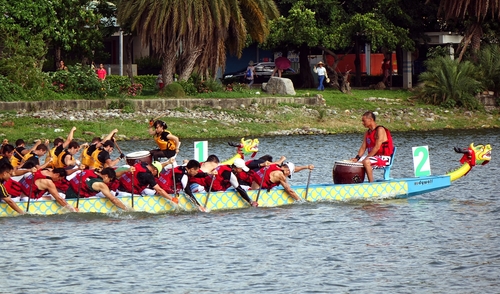Training for Traditional Boat Race

Image credit: Shutterstock.com
One of the most important aspects of traditional boat racing is team synchrony, and this is why it is crucial that all members of the crew adopt the same way of paddling.
To begin, there are four basic phases to a stroke:
1. Catch - Turn your body slightly inwards towards the centre of the boat and lean forward, then submerge your paddle fully in the water.
2. Pull - Lean back and pull the blade through the water.
3. Finish - Follow the pull through till the blade is out of the water.
4. Reach - Lean forward again with your arm extended to begin the 'catch' phase for the next stroke.
With time and practice, the distance of your race will not matter because your body will soon be conditioned to keep paddling till the finish line. The abdominal muscles and shoulders are made use of most in paddling, so do plenty of crunches and shoulder lifts to strengthen them.
A good way to practice extending your reach is to sit behind someone taller when training in the boat. This is because the taller crew mate will have a longer reach, thus making you lean forward more to match his stroke. Do note that you need to already have strong abdominals and back muscles as this slight overextending can strain both muscles over time.
Another practice to help you paddle faster and harder is to sit at the back of the boat while training. This is an effective form of resistance training as you need to battle against the waves created by teammates in front of you. Alternatively, you could sit in the front of the boat to paddle while teammates behind you create drag by holding their paddles straight down and still in the water.
While on land, you can simulate the effects of paddling by first visualising the stroke pace and intensity typical of your crew’s water training. Time your on-land cardio training to your team’s usual race time. After that, take a brief 'rest' period of no more than one minute. This does not mean you stop moving, but rather for you to continue to walk or ride the bike at an easy pace. Then, repeat the cardio training at a fast pace.
Keep in mind that you will need to build up your stamina. If you need your muscles to perform at optimum level, you should train it to sustain the same power level for at least half a minute more than your team’s usual time. The level of endurance and strength is often the key factor in determining if you can sustain stamina for multiple heats. This is why on-land conditioning is as important as on-water practice.
To receive the latest updates on the happenings in the Singapore sports scene, or to find out more about some of the latest programmes on offer at ActiveSG, like our Facebook page here.





![ActiveSG Academies and Clubs Logo (Solid Colour)[8647]](https://www.activesgcircle.gov.sg/hs-fs/hubfs/ActiveSG%20Circle%202023Theme/images/ActiveSG%20Academies%20and%20Clubs%20Logo%20(Solid%20Colour)%5B8647%5D.png?width=150&height=65&name=ActiveSG%20Academies%20and%20Clubs%20Logo%20(Solid%20Colour)%5B8647%5D.png)



-01.png?width=200&height=141&name=Team%20Singapore%20Logo%20(Red)-01.png)



